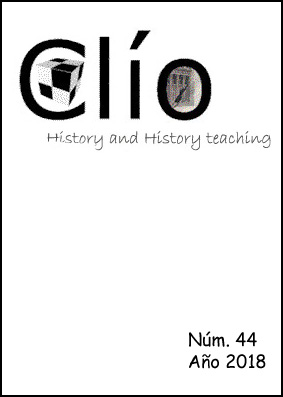Gamification: A resource for motivation and fidelization at museums
DOI:
https://doi.org/10.26754/ojs_clio/clio.2018448677Keywords:
Gamification, museums, users, motivation, fidelization, strategiesAbstract
Gamification, understood as the application of the philosophy of game to non-play contexts, is experiencing a spectacular development in areas of diverse nature in recent years. While it is more commonly accepted that the main functions of museums are to preserve and make their own collections public, it is essential for them to be able to connect successfully with users using innovative and accessible means and strategies. In the following pages we will show how gamification is an ideal resource to motivate, retain and influence user behaviour.
Downloads
References
AEVI (2015). Videojuegos y Adultos. www.aevi.org.es/documentacion/estudios-y-analisis
AEVI (2016). Anuario de la Industria del Videojuego. www.aevi.org.es/web/wp-content/uploads/2016/06/MEMORIA-ANUAL_2015_AEVI_-definitivo.pdf
Aguado, C. (2016). Gamificación y Content Marketing para promover la visita a museos de los nativos digitales. Congreso Internacional en Educación, Arte y Humanidades CIEDARH “Educación para el cambio”. https://www.researchgate.net/publication/299352479_Gamificacion_y_Content_Marketing_para_promover_la_visita_a_museos_de_los_nativos_digitales_Gamificacion_and_Content_Marketing_to_promote_the_visit_to_museums_of_the_native_digital
Aguirrezabal, P., Peral, R., Pérez, A. & Sillaurren, S. (2014). Designing history learning games for museums: an alternative approach for visitors engagement. Proceedings of the 2014 Virtual Reality International Conference. New York.
Bunchball (2010). Gamification 101: An introduction to the use of game dynamics to influence behavior. www.bunchball.com/sites/default/files/downloads/gamification101.pdf
Caillois, R. (1986). Los juegos y los hombres. México.
Clar, V. (2012). Gamification: Definición. Misapisportuscookies. Disponible en: http://www.misapisportuscookies.com/2012/11/gamification-1-definicion/
Cortizo, J.C., Carrero, F., Monsalve, B., Velasco, A., Díaz del Dedo, L.I. & Pérez, J. (2011). Gamificación y docencia: Lo que la Universidad tiene que aprender de los videojuegos. VII jornadas internacionales de innovación universitaria (ponencia). Recuperado de: http://hdl.handle.net/11268/1750
Currier, J. (2008). Gamification Game Mechanics is the new marketing. Recuperado de: blog.oogalabs.com/2008/11/05/gamification-game-mechanics-is-the-new- marketing/.
Charsky, D. (2010). From Edutainment to Serious Games: A Change in the Use of Game Characteristics. Games and Culture 5 (2), 177–198.
Deterding, S., Dixon, D., Khaled, R. & Nacke, L. (2011). From Game Design Elements to Gamefulness: Defining Gamification. MindTrek 11, 9-15.
Ferreras, R. (2014). Educa+: reflexiones y propuestas para el museo como espacio educativo. PH: Boletín del Instituto Andaluz del Patrimonio Histórico 85, 20-21.
Gee, J. P. (2007). Are videogames good for learning?. En Castell, S. & Jenson, J. (Eds.), Worlds in Play. New York: Lang, 323-336.
Groh, F. (2012). Gamification: State of the art definition and utilization. Proceedings of the 4th Seminar on Research Trends in Media Informatics RTMI 2012. Ulm.
Huizinga, J. (2008). Homo Ludens. Madrid.
Jiménez, S. (2014). Gamificación, generando compromiso con la cultura. Anuario AC/E de cultura digital, 30-39.
Kapp, K. (2012). The Gamification of Learning and Instruction: Game-Based Methods and Strategies for Training and Education. San Francisco.
Kim, B. (2015). Gamification in Education and Libraries. Library Technology Reports 51 (2), 20-28.
Kotler, G., Kotler, P. & Kotler, W.I. (2008). Museum Market- ing & Strategy. Designing Missions, Building Audiences, Generating Revenue & Resources. San Francisco.
Lee, J.J. & Hammer, J. (2011). ‘Gamification in education: What, How, Why bother?’. Academic exchange quarterly 15 (2), 1-5.
McGonigal, J. (2011). Reality is broken. Why games make us better and how they can change the world. London.
Novillo, M. A. & Salazar, G. (2017). La atención. Las funciones ejecutivas del cerebro protagonistas de una revolución educativa. Madrid: Aranzadi, 91-104.
Revuelta, F.I. & Guerra, J. (2012). ¿Qué aprendo con videojuegos? Una perspectiva de meta- aprendizaje del videojugador. RED, Revista de Educación a Distancia 33, 1-25.
Rubio, J., López, B & Jiménez, J. M.ª (2013). El juego como recurso educativo. Timeliner: un videojuego para la enseñanza-aprendizaje del español como lengua extranjera. II Congreso Internacional sobre Aprendizaje, Innovación y Competitividad (CINAIC 2013). Madrid.
Terrill, B. (2008). My coverage of lobby of social gaming. www.bretterrill.com/2008/06/my-coverage-of-lobby-of-social-gaming.html
Werbach, K. & Hunter, D. (2012). For the Win: How Game Thinking Can Revolutionize Your Business. Pennsylvania.
Zichermann, G. & Cunningham, C. (2011). Gamification by Design: Implementing Game Mechanics in Web and Mobile Apps. California.
Downloads
Published
How to Cite
Issue
Section
License
Copyright (c) 2018 Miguel Ángel Novillo López, Óscar Costa Román, Amelia Barrientos Fernández, Francisco Javier Pericacho Gómez, Amaya Arigita García, Roberto Sánchez Cabrero

This work is licensed under a Creative Commons Attribution-NonCommercial-ShareAlike 4.0 International License.
This work is licensed under a Creative Commons Attribution-NonCommercial-ShareAlike 4.0 International License.
Copyright remains the property of authors. Permission to reprint must be obtained from the authors and the contents of JoS cannot be copied for commercial purposes. JoS does, however, reserve the right to future reproduction of articles in hard copy, portable document format (.pdf), or HTML editions of JoS.






